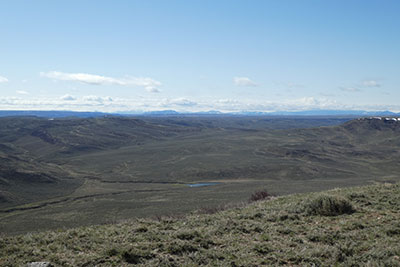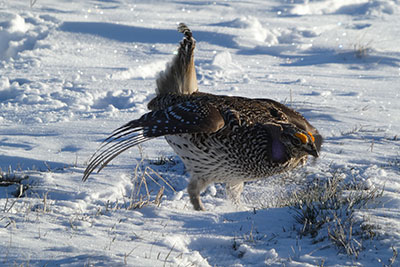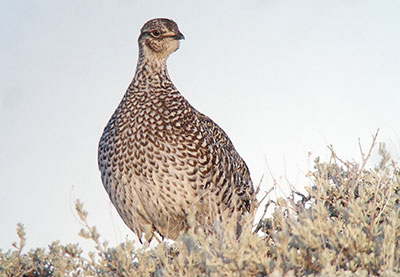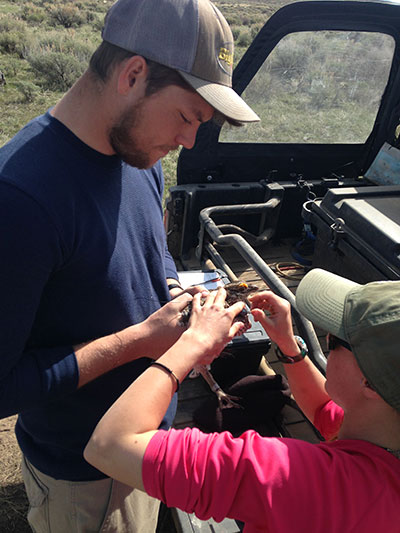In spring 2017, we initiated a three-year field study investigating the population demography, habitat selection, and subspecies status of Columbian sharp-tailed grouse (Tympanuchus phasianellus columbianus) in south-central Wyoming. Our research is a collaboration with Bowling Green State University, the Wyoming State Office and Rawlins Field Office of the USDI Bureau of Land Management, Wyoming Game and Fish Department, and the USDA Medicine Bow-Routt National Forest.
Columbian sharp-tailed grouse are considered a species of greatest conservation need under Wyoming’s state wildlife action plan (Keinath et al. 2010). However, little is known about the ecology and population status of Columbian sharptails in south-central Wyoming, which are the main population the state. Most of what is known of this grouse consists of two studies in the 1980s evaluating sharp-tailed grouse habitat selection (Oedekoven 1985; Klott 1987; Klott and Lindzey 1989, 1990), and one recent study that identified new lek sites in our study area (Smith et al. 2016). In addition, Spaulding et al. (2006), through analysis of genetic samples from birds in Wyoming and adjacent northwest Colorado, questioned whether this population consisted of Columbian, plains (T. p. jamesi), or a different subspecies of sharp-tailed grouse. It is thus important to identify demographic rates, seasonal resource selection, and the subspecies status of this population to inform managers and prioritize conservation needs.
 |
 |
 |
 |
To identify these needs we are capturing and attaching VHF radio-transmitters to adult
birds in the spring to follow their survival and habitat selection throughout the
year. Additionally, we are collected DNA samples from captured grouse and other sharp-tailed
grouse populations (known Columbian sharp-tailed grouse in Idaho and known plains
sharp-tailed grouse in eastern Wyoming) to identify what subspecies sharp-tailed grouse
in south-central Wyoming belong to. Specifically, our study seeks to answer the following
questions:
- What are the key demographic rates and how do these influence the population growth rate?
- What habitat features do sharp-tailed grouse select on a seasonal basis in this region?
- Do different habitat features, including geographic, vegetative, and anthropogenic features, influence sharp-tailed grouse survival?
- What subspecies of sharp-tailed grouse do grouse in south-central Wyoming belong to?
Literature Cited
Keinath, D. A., M. A. Andersen, and G. P. Beauvis. 2010. Range maps for Wyoming’s species of greatest conservation need. Report prepared for the Wyoming Game and Fish Department by the Wyoming Natural Diversity Database, Laramie, WY. January 19, 2010.
Klott, J. H. 1987. Habitat use by sympatrically occurring sage grouse and sharp-tailed grouse with broods. Thesis, University of Wyoming, Laramie, USA.
Klott, J. H., and F. G. Lindzey. 1989. Comparison of sage grouse and sharp-tailed grouse leks in south central Wyoming. Great Basin Naturalist 49:275–277.
Klott, J. H., and F. G. Lindzey. 1990. Brood habitats of sympatric sage grouse and Columbian sharp-tailed grouse in Wyoming. Journal of Wildlife Management 54:84–88.
Oedekoven, O. O. 1985. Columbian sharp-tailed grouse distribution and habitat use in south central Wyoming. Thesis, University of Wyoming, Laramie, USA.
Smith, K. T., J. L. Beck, T. W. Mong, and F. C. Blomquist. 2016. Identification of
Columbian sharp-tailed grouse lek sites in south-central Wyoming. Western North American Naturalist 76:135–141. 
Spaulding, A. W., K. E. Mock, M. A. Schroeder, and K. I. Warheit. 2006. Recency, range expansion, and unsorted lineages: implications for interpreting neutral genetic variation in the sharp-tailed grouse (Tympanuchus phasianellus). Molecular Ecology 15:2317– 2332.
